The Best Balsamic Vinegar, According to Our Test Kitchen
Dotdash Meredith and Yahoo Inc. may earn commission or revenue on some items through the links below.
These are our favorite balsamic vinegars for every budget.
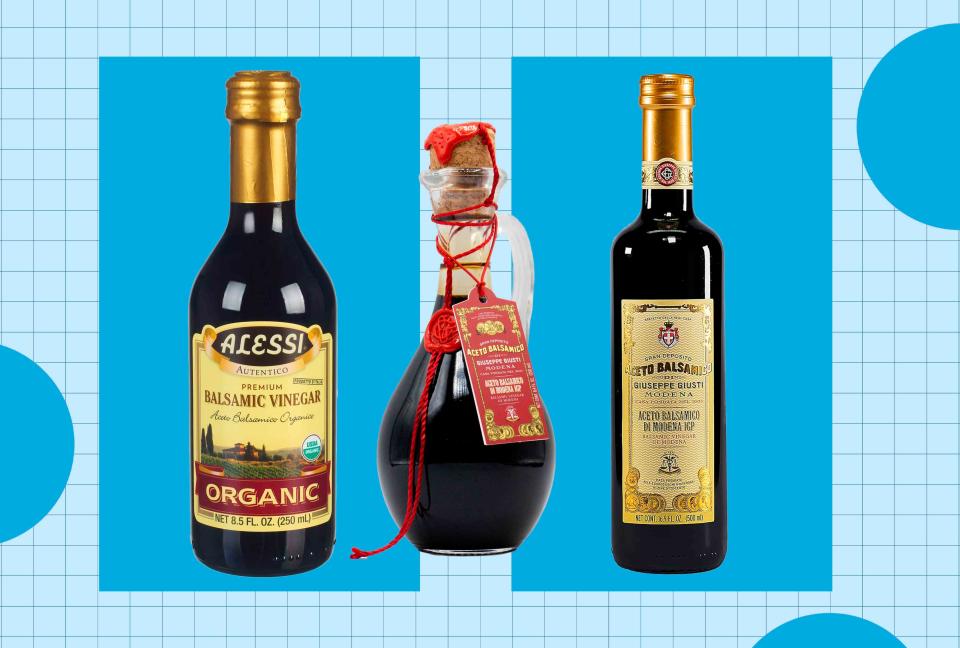
Courtesy of Brand
In the EatingWell Test Kitchen, we love balsamic vinegar—in vinaigrettes for our salads, whether it's used for marinades or dishes like this balsamic chicken. Not only does this tangy condiment add flavor, it also hosts a number of surprising health benefits, from aiding in digestion to even improving the appearance of your skin. Plus, did we mention it tastes delicious?
"I use a lot of balsamic at home," says food editor Devon O'Brien. "My mom made balsamic vinaigrette for a tossed salad at dinnertime every single day, and I find myself reaching for the same in adulthood. Balsamic has such a deep flavor compared to other vinegars, a nice musk and a little sweetness. I use it in salads, of course, but also for pairing with cheese, drizzling on pizzas and even a little in some pasta dishes." She adds, "I also always have a balsamic glaze or reduction on hand for drizzling on fresh mozzarella and tomatoes or on top of cooked pizza."
But how do you know the best balsamic vinegar to buy? It depends on a few factors, including how you plan to use it. Here's our advice on choosing, plus a few top picks to buy at the grocery store or online.
Our Balsamic Vinegar Recommendations
Best Overall: Fini Balsamic Vinegar of Modena
Also Great: Giuseppe Giusti Premio Balsamic Vinegar of Modena
Best Value: Alessi Organic Balsamic Vinegar
Best Splurge: Giuseppe Giusti Dense Balsamic Vinegar
Best for Dressings: Colavita Balsamic Vinegar of Modena
Best Overall: Fini Balsamic Vinegar of Modena
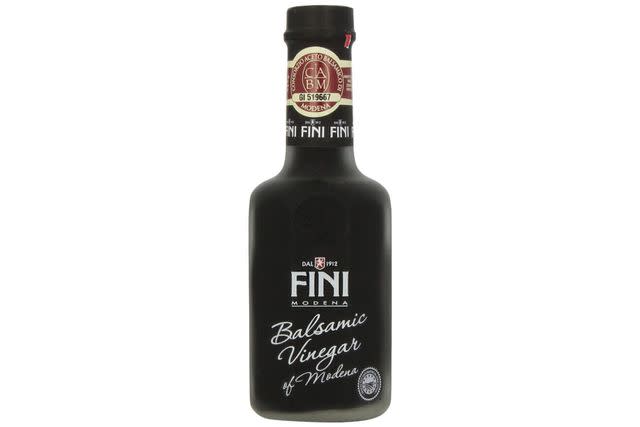
Amazon
What we like: This classic balsamic vinegar has great flavor at a reasonable price point.
What to know: The Fini isn’t a favorite with some folks who prefer a more robust flavor.
This classic balsamic vinegar has a smooth, balanced flavor that makes it ideal for a variety of uses beyond dressing a salad. This variety is aged for a full year to give it a balanced, mellow tang. It’s an excellent addition to marinades and sauces, but can also add a zing to fresh fruit or even vanilla ice cream. We also think the price point makes this balsamic vinegar an excellent choice if you want to experiment with more complex flavors but aren’t quite ready to commit to a more expensive variety.
Size: 8.5 oz. | Age: 12 months | Region: Modena, Italy | Grape Variety: Trebbiano and Lambrusco | IGP or DOP Stamp: IGP
Also Great: Giuseppe Giusti Premio Balsamic Vinegar of Modena
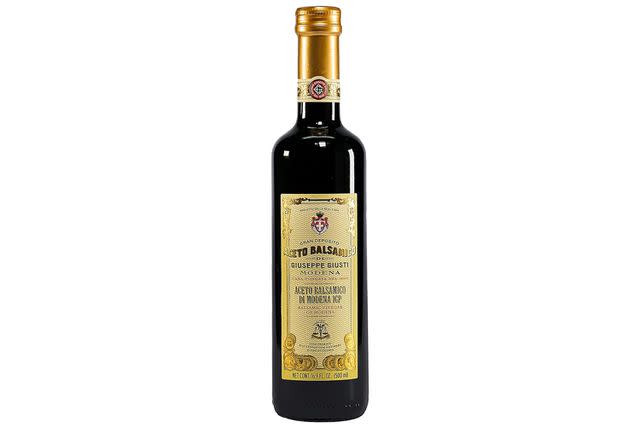
Amazon
What we like: This richly-flavored option has a balanced taste that holds up equally well on meats, fruits and cheeses.
What to know: The consistency is thin and may not impress those who prefer a thicker balsamic.
Giuseppe Giusti has been producing balsamic vinegars since the Renaissance, and while some of its bottles can go for hundreds of dollars, the company also produces more affordable batches that allow you to sample what hundreds of years’ worth of honing a craft can produce. Tart and sweet, this balsamic is aged for four years to let it take on the woody notes of the barrels it matures in. Its flavors hold up well to a variety of foods, but the price point gives you permission to use it more liberally in recipes like marinades.
Giuseppe Giusti fans take note: "They make several levels of balsamic all the way up to very expensive, very old vinegar," says food writer Jim Romanoff. "Plus, if you're a bargain shopper you can often find their vinegars at T.J. Maxx or Marshalls. I find a good deal makes it even more special."
Size: 16.9 oz. | Age: 4 years | Region: Modena, Italy | Grape Variety: Trebbiano and Lambrusco | IGP or DOP Stamp: IGP
Best Value: Alessi Organic Balsamic Vinegar
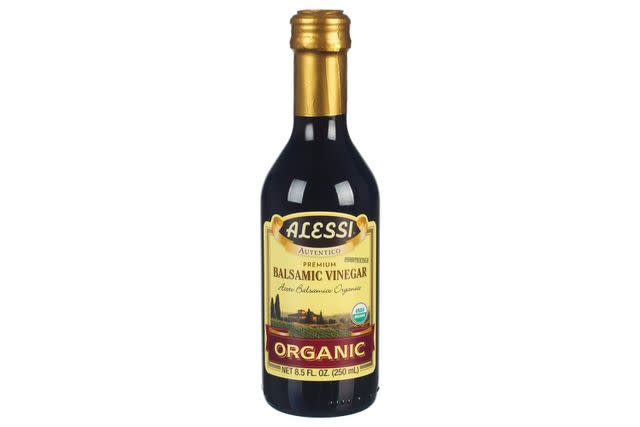
Amazon
What we like: The most affordable of the bunch, this organic balsamic is easy to find in most grocery stores.
What to know: With more of an acidic bite, this balsamic is better suited for marinades than drizzling.
The good news is that you don't have to spend a bundle for good-quality balsamic. "Colavita and Alessi are my go-to inexpensive grocery store grabs," says O'Brien. This tangy organic option is not only affordable, it’s also widely available, making it an excellent candidate for a pantry staple. Use it to elevate Brussels sprouts from side to main dish, or turn onions into a rich, decadent dish. This balsamic is thinner and more acidic than some other options, so it’s better off playing a supporting role in your dish as opposed to becoming the star.
Size: 8.5 oz. | Age: 4 years | Region: Region not specified; made in Italy | Grape Variety: Not indicated | IGP or DOP Stamp: Not indicated
Best Splurge: Giuseppe Giusti Dense Balsamic Vinegar
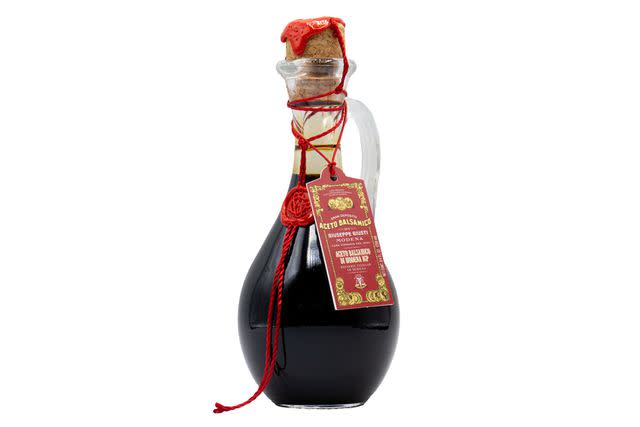
Amazon
What we like: This thick, aromatic balsamic provides a piquant sweetness that makes it ideal for drizzling on meats or desserts.
What to know: This balsamic vinegar is the most expensive on our list, so you’ll probably want to reach for a cheaper bottle if you need to whip up a marinade.
This balsamic vinegar is our favorite splurge pick for its thick, honeyed sweetness that makes it a perfect accompaniment for fresh fruit and ice cream. Even better, the flagon-like corked bottle adds an elegant touch to your countertop. Since this balsamic is a splurge (and only available at Williams Sonoma), you’ll probably want to save it for special occasions. Still, we think the piquant flavor it adds to a rich pork tenderloin or fresh strawberries makes it worth the investment.
Size: 8.45 oz. | Age: Not indicated | Region: Modena, Italy | Grape Variety: Not indicated | IGP or DOP Stamp: IGP
Best for Dressings: Colavita Balsamic Vinegar of Modena
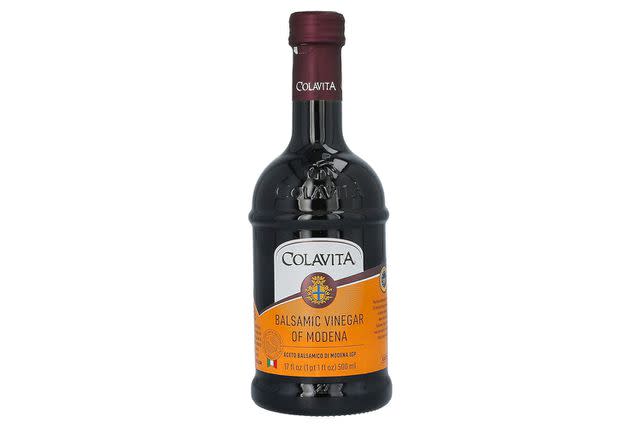
Amazon
What we like: This affordable find is flavorful without being overwhelming in salads and sandwiches.
What to know: This Colavita version has a thinner consistency and more acidic bite, so it’s not as ideal for desserts.
This bargain find is readily available in most stores and is great for adding a touch of acidity to a hearty tomato sandwich or a veggie-packed salad. If you find it a bit too pungent for your taste, it’s easy to reduce it to a sweeter glaze that pairs wonderfully with everything from roasted cauliflower to savory salmon. While it may lack the richness and viscosity for desserts, it’s another affordably-priced staple you’ll want to always have on hand.
Size: 17 oz. | Age: Not indicated | Region: Modena, Italy | Grape Variety: Not indicated | IGP or DOP Stamp: IGP
The Bottom Line: The Best Balsamic Vinegar
If you want a classic, robust balsamic vinegar that you can use for drizzling or for marinades, the Fini Balsamic Vinegar of Modena (view at Amazon) is our top pick. However, if you’re looking for an affordable option that you can use in marinades and sauces, we think the Alessi Organic Balsamic Vinegar (view at Amazon) makes an excellent budget-friendly alternative.
Choosing a Balsamic Vinegar
When choosing a balsamic vinegar, one factor is what you'll be using it for. If it is going to be the star of the show—say, simply drizzled over vegetables or even fruit—you might want to spring for something a bit fancier, while if you are using it in a marinade, you can get away with something cheaper. When you are shopping for balsamic, pay attention to these three Cs.
Certification
"Balsamic from Italy has a certification to protect authenticity and quality—look for a DOC label," explains Romanoff. In addition to the DOC certification, Romanoff looks for vinegars with one of these two regional labels: Balsamico Tradizionale di Modena and Balsamico Tradizionale di Reggio Emilia. Both use traditional barrel methods to make their vinegar.
Color
At the store, take a look at the color of the vinegar. "Often I look at color first, if possible. I want one that is rich and dark, not translucent like red-wine vinegar," says O'Brien.
Consistency
Romanoff notes that while a thick consistency can be a sign of a quality balsamic, it can also be a bit of a trick. "I used to look at the body to see that it was more syrupy than watery, like I'd enjoyed with better balsamic, but then I learned that lower-quality ones were artificially thickened all the time."
Our Search for the Best Balsamic Vinegar
To find the best balsamic vinegar, we interviewed food editors and writers to find out which brands they stock their pantries with. We looked at factors such as taste, availability and cost to compile a list of balsamic vinegars which represented a range of prices. Our list includes everything from balsamic vinegars that are nuanced enough for drizzling on a dessert to those that are bold enough to hold their own in a marinade.
Common Questions
How long does balsamic vinegar last?
Bottles of balsamic vinegar typically last between 3 and 5 years if stored properly. They’re still safe to consume after that time, but the flavor may degrade a bit. To extend the shelf life of your balsamic vinegar, keep it tightly capped in a cool, dark place. While it doesn’t require refrigeration, if you regularly use balsamic vinegar for cold items like salads, you may prefer to store it in your refrigerator. This is purely a matter of personal preference, however.
What does IGP and DOP mean?
These terms are shorthand for Italian certifications, and stand for Indicazione Geografica Protetta (Protected Geographical Indication) and Denominazione di Origine Protetta (Protected Designation of Origin), respectively. IGP is the most common designation, and means a product was made in a certain area, but not all the ingredients are necessarily sourced from that region (so your balsamic vinegar will be made in Modena according to specific production processes, but the grapes may not necessarily be from that region). A DOP designation guarantees that everything from the grapes to the packaging of your balsamic vinegar comes from one specific region and is produced according to very specific methods
What's the difference between white balsamic and regular balsamic vinegar?
"White balsamic is basically the same as regular, but made with white-wine vinegar instead of red-wine vinegar," explains O'Brien. "It's great for dishes where you want that balsamic flavor but don't want to muddy the color of your food—think salads with peaches, etc."
Romanoff finds white balsamic to usually be sweeter and less complex than regular balsamic. "I often use it as a sweetener along with other vinegar in a dressing or in a dish that I want to be sweet and tart but don't need the complexity of dark balsamic." Try white balsamic in recipes like this one for chicken cutlets with rhubarb sauce—the white balsamic gives the dish the sweet-tart complexity of balsamic without affecting the color of the dish. Colavita and Alessi are good picks for white balsamic too.
When should I use my fancy balsamic vs. my everyday balsamic?
"My philosophy is to use the best ingredient you can for anything you're making," says Romanoff. "A really amazing balsamic makes an amazing vinaigrette. If I'm cooking with balsamic and it's not going to be the primary flavor, I use my everyday balsamic. For dressings I usually use the fancier stuff, sparingly—after all, I can't live at T.J. Maxx."
And if you are going to splurge on a really fancy bottle of balsamic, save it for special occasions to drizzle on fresh fruit and even ice cream. "I keep an embarrassingly expensive, teeny-weeny bottle of balsamic in an antique jelly cupboard with the 'fancy' plates and glasses," says Romanoff. "In the spring and early summer when strawberries are at their best, I take the tastiest specimen I can find and anoint it with a few drops of the precious elixir from Modena. Then I try to forget the bottle is there for another year. I've had it for at least 15 years at this point."
Related: 30 Balsamic Vinegar Recipes You'll Want to Make Forever
Our Trusted Expertise
This article was updated by Katie Tuttle, a commerce editor and contributor to publications such as Food & Wine and The Spruce Eats. Her favorite use of balsamic vinegar is as an ingredient in Beet & Goat Cheese Salad. The original version of this article was written by Devon O’Brien, former EatingWell senior food editor and current associate editorial director for Allrecipes. To write this article, Devon consulted Jim Romanoff, a food writer and former food editor for EatingWell.
This article was edited by Kayleigh Drake, an EatingWell commerce editor who has never met a balsamic vinegar she didn't like.
Read the original article on Eating Well.

